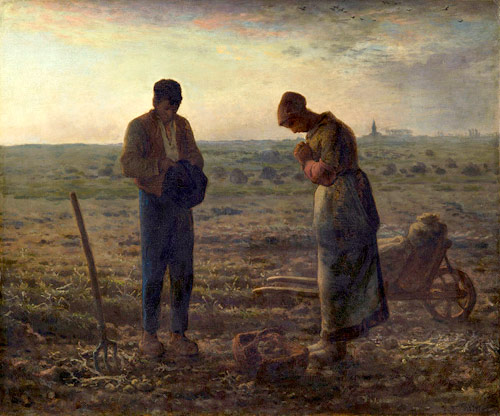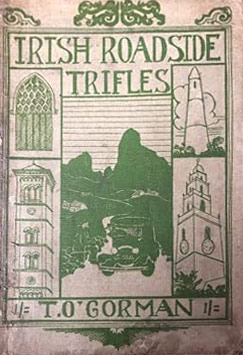The Angelus.
When about halfway on the high road between Dublin and Cork, I decided to have tea in the Cathedral town of Thurles and I said, “When thus refreshed, I shall think nothing of the 73 mile journey from there to the southern capital”.
These thoughts were in my mind, when a young girl on a bicycle came in the opposite direction and after looking at me, blessed herself as she was passing. “Now that’s queer” I said. “I wonder why she blessed herself; have I frightened her in any way? Would the devil by any chance have momentarily thrown his shadow over me and caused her to shelter behind the armour of that protecting sign”.
Certainly he has been busy in these parts; yonder is the mountain called by his name, (referring to the Devil’s Bit) and which so unmistakably bears his mark.
I felt anxious, and no wonder: but then I taught again on my journey, and looking at my watch I saw that the minute hand was just past the stroke of six, and I at once saw the explanation: it was the Angelus.
My hearing is not so good, and I did not hear the bell; but I have no doubt when she was passing there came floating through the air from the spire in Templemore, the sound of the evening bell, which she promptly answered by her act of homage. I was glad that the incident turned out to be so edifying, and that Satan was not playing any of his tricks.
In no place is this beautiful custom of saying the Angelus prayer more observant than in County Tipperary, and particularly in the town of Thurles, to which I was then traveling. There the great bell has a persuasive power that will not be denied. A tuneful time announces the solemn toll; and then work ceases, and heads our bared, and men’s minds are turned to the opening act in the great scheme of the redemption: when an angel visiting a house in Galilee saluted the occupant “Hail Mary”. Men at street corners drop their conversation on the scarcity of occupation and on the price of stout and tobacco, and turn their minds to the object of this heavenly visitor.
When doing business with the shopkeeper you will find that he suddenly ceases talking and when looking up to see why your question is unanswered, you will find him with bowed head saying the Angelus prayer.

The custom is poetical and appealing; and perhaps no picture has more copies than Millet’s famous “Angelus,” (Jean-François Millet 1814–1875), where he portrays two field workers with bowed heads and clasped hands, engaged in prayer.
A copy of this picture was the subject of my contemplation when on one occasion I was waiting in a room in the palace at Thurles, and I thought it a very suitable picture for that place.
I also saw on the same occasion, outside in the back lawn, two large bells hanging on a low suspension rack over a platform of cement. It looked as if this place of honour was their reward after long service. And so it was, for only eight miles away, but hundreds of years ago, they proclaimed the Angelus hour for the peace abiding monks, who on the other side of the Suir Valley, ere the steep sides of Slieveardagh hills are reached; built their Abbey church; and there for many years those bells controlled their working and their praying hours. But disruptive days set in, and the Iconoclasts* of that time cast the bells from the belfry tower, and as things of evil, made some earth cavern or river bed their ignoble burial place. But in time their good angel brought them to the light of the day and now at Thurles, in quiet seclusion in the Cathedral shade, they faintly vibrate in sympathy with the great bells overhead.
*Iconoclasts meaning a person who destroys religious images or opposes their veneration and who attacks settled beliefs or institutions.
In this Cathedral the Waterford born operatic composer William Vincent Wallace spent a time as organist. And falling under the influence of the Angelus, he introduced into his opera Maritana, the beautiful Angelus scene, where the chorus, as Spanish peasants sing, so appealingly, the words: “See us kneel and hear us pray”. The Spanish are as faithful to the Angelus call as we Irish, and this is but natural; for where we not the same people as one time? Was it not from the sunny lands of Spain that the proud Milesians set sail in their good ships to this, their Isle of Destiny, to use a new combination of Moore’s well-known words. And though the more northern climate may have changed us somewhat, yes in fundamentals we are like our Spanish cousins and particularly in our loyalty to the Angelus bell.
While the bells of Thurles have this compelling power, the Cathedral has a mysterious influence; for as one enters one beholds emerging out of the gloom, pierced by stained glass rays a magic structure. Gently the gloomy veil rolls off and then come into view pillars and many arches; the far distant double-sided altar circled by the spacious Ambulator; the side altars with their splendid statues; and last, the vaulted covering overhead. The Cathedral, as it were, unveils itself for each visitor, comes forth to meet one, inviting you to stay and pray. This is the result of the peculiar light in the place; just that mixture of daylight and gloom which gives a vagueness that is associated with the idea of mystery and beauty.
The builders of the Thurles Cathedral, understanding the value of this, and seeing its effect in a church in Italy, wisely decided to reproduce it in Thurles by copying the Italian Church. And crowning their work, they hung in the lofty campanile the splendid bells, whose brass tongues persistently and untiringly compel men’s minds to ponder on the Joyful Mystery of the Annunciation.


Leave a Reply